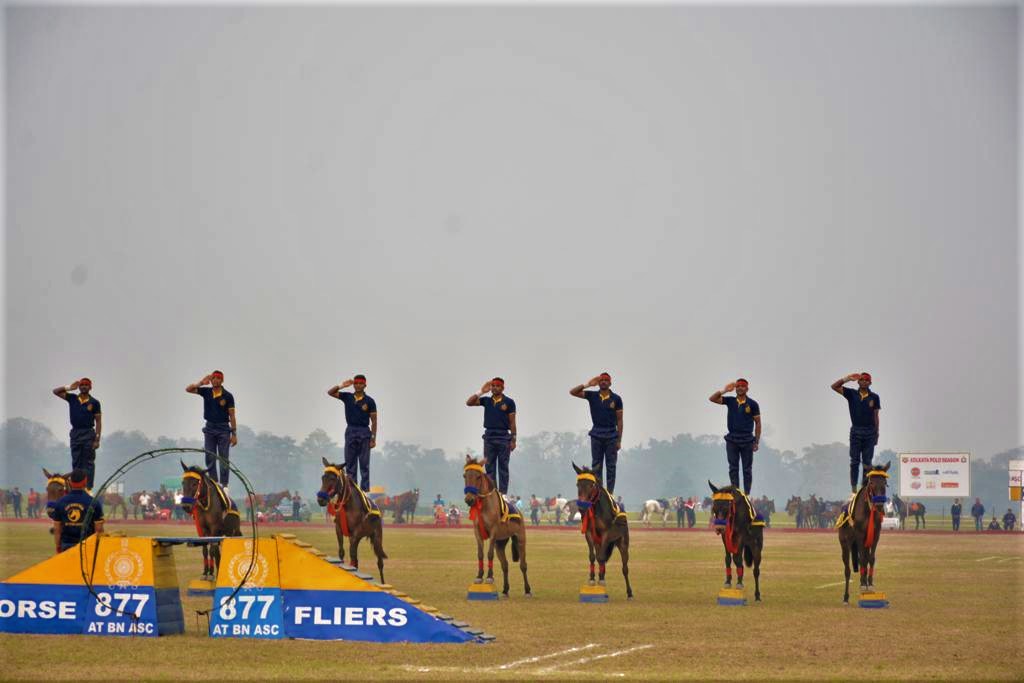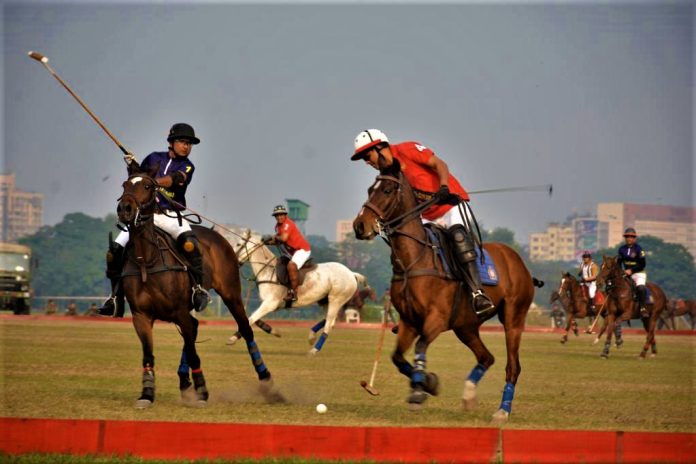POLO is one of the Royal Sports still gaining popularity in India in recent times, especially among the defense personnel and for Olympics aspirants.
This year the City of Joy will see the best of POLO players in action during the following CUPs to be played at Pat Williamson Ground Race Course, Hastings, Kolkata, West Bengal 700022.
The dates of the Polo finals are given below.
The dates are as follows:-
(a) Army Commander Polo Cup – 21 Dec 22 (Chief Guest: GOC-in-C Eastern Command).
(b) Fort William Challenge Cup – 25 Dec 22 (Chief Guest: Chief of Staff Eastern Command).
(c) Rising Sun Polo Cup – 30 Dec 22 (Chief Guest: QMG).

People may be interested in the History of POLO:
The game’s English name derives from the Balti language, from its word for ‘ball’, polo. It is cognate with the Standard Tibetan pulu, also meaning ‘ball’.
Although the exact origins of the game are not certain, many scholars suggest it most likely began as a simple game played by Iranic and Turkic equestrian nomads in Central Asia. It was developed and formalised in Ancient Iran (Persia) as “chovgan” (čowgān), becoming a national sport played extensively by the nobility. Women played as well as men. During the period of the Parthian Empire (247 BC to 224 AD), the sport had great patronage under the kings and noblemen.
According to The Oxford Dictionary of Late Antiquity, the Persian ball game was an important pastime in the court of the Sasanian Empire (224–651). It was also part of the royal education for the Sasanian ruling class. Emperor Shapur II learnt to play polo at age seven in 316 AD.
Middle Ages and Early Modern era reference found to POLO as below:
Naqsh-e Jahan Square in Isfahan, Iran, is the site of a medieval royal polo field
Valuable for training cavalry, the game was played from Constantinople, where Emperor Theodosius II constructed a polo ground early in the 5th century, to Japan by the Middle Ages. The game also spread south to Arabia and to India and Tibet.
Abbasid Baghdad had a large polo ground outside its walls, and one of the city’s early 13th century gates, the Bab al Halba, was named after these nearby polo grounds.
The game continued to be supported by Mongol rulers of Persia in the 13th century, as well as under the Safavid dynasty. In the 17th century, Naqsh-i Jahan Square in Isfahan was built as a polo field by King Abbas I.
The game was also learnt by the neighbouring Byzantine Empire at an early date. A tzykanisterion (stadium for playing tzykanion, the Byzantine name for polo) was built by Emperor Theodosius II (r. 408–450) inside the Great Palace of Constantinople. Emperor Basil I (r. 867–886) excelled at it; Emperor Alexander (r. 912–913) died from exhaustion while playing and Emperor John I of Trebizond (r. 1235–1238) died from a fatal injury during a game.
Tang dynasty Chinese courtiers on horseback playing a game of polo, 706 AD
After the Muslim conquests to the Ayyubid and Mameluke dynasties of Egypt and the Levant, their elites favoured it above all other sports. Notable sultans such as Saladin and Baybars were known to play it and encourage it in their courts. Polo sticks were featured as one of the suits on the Mamluk precursor to modern-day playing cards. Europeans transformed the polo stick suit into the “clubs” of the “Latin” decks, as polo was little known to them at that time.
The Georgians Playing Polo in the Kingdom of Imereti, by Italian missionary Teramo Castelli, 1640.
The game spread to South Asia where it has had a strong presence in the northwestern areas of present-day Pakistan Occupied Kashmir region of India (including Gilgit, Chitral, Hunza and Baltistan) since at least the 15th–16th century. Qutubuddin Aibak (r. 1206–1210), originally a Turkic slave who later founded the Mamluk dynasty (1206–1290) Delhi Sultanate, was accidentally killed during a game of polo when his horse fell and he was impaled on the pommel of his saddle.
Polo likely travelled via the Silk Road to China where it was popular in the Tang dynasty capital of Chang’an, and also played by women, who wore male dress to do so; many Tang dynasty tomb figures of female players survive. According to The Oxford Dictionary of Late Antiquity, the popularity of polo in Tang China was “bolstered, no doubt, by the presence of the Sasanian court in exile”. A “polo-obsessed” noblewoman was buried with her donkeys on 6 October 878 in Xi’an, China.
An archaic variation of polo, regionally referred to as buzkashi or kokpar, is still played in parts of Asia.
In modern India, we too have a well-managed POLO association called “The Indian Polo Association (IPA)”.It is the governing body for polo in India. Most of the IPA’s major activities are executed by the 61 Cavalry Unit of the Indian Army. The IPA’s registered office is co-located with the 61 Cavalry’s B Squadron.
The IPA was established in 1892. Legally, it is a non-profit association registered under the Societies Registration Act, 1860. Prominent teams of the pre-World War II period included Alwar, Bhopal, Bikaner, Jaipur, Hyderabad, Patiala, Jodhpur, Kishengarh and Kashmir. The majority of the Cavalry regiments of the British Army and the British Indian Army also fielded teams, the most prominent amongst them were the Central India Horse (CHI), Prince Albert Victor Own Cavalry (PAVO’s Cav), the Inniskilling Dragoon Guards, the 10th Royal Hussars, the 15th Lancers, and the 17/21st Lancers.
The outbreak of the second World War and the mechanization of cavalry units resulted in a decline in interest in Indian polo. The IPA invited the Argentine national polo team to visit India in 1950 and play an exhibition games across the country in a bid to revive interest in the sport. The Argentine team participated in tournaments in Jaipur, Delhi and Bombay. The Pakistan Army polo team visited India in 1955. The IPA also revived the Indian Polo Championship in 1956, after a gap of 17 years. The India national polo team participated in the 1957 World Championship in France and won the tournament. These events helped revive interest in polo in the country. Indian polo received another boost after the Indian Army officially adopted polo as a sport granting access to new grounds and stables of horses.
Indian President Fakhruddin Ali Ahmed consented to be the Patron-in-Chief of the IPA, resulting in the introduction of a new trophy called The President’s Cup in 1975. The IPA marked its 100th anniversary in 1992.
In the year 1992 the IPA completed 100 years and since then polo is on an upward trend in the country. Today we have 33 Polo Clubs registered with IPA. Polo has been revived at Leh in Jammu and Kashmir, at Udaipur and Jodhpur in Rajasthan, Hyderabad, and Bangalore in South India. Polo is now not only the domain of the Army but a number of corporate and industrial houses are supporting teams in the domestic polo circuit.
The Indian Polo Association has the Chief of the Army as its President and is the national governing body of Polo in the country. Under the aegis of IPA various tournaments are conducted across all the clubs in India throughout the year.
Inputs from Wikipedia and the public domain:




















